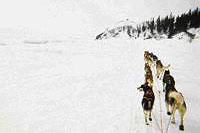 |
|||||||||||||||||

Iditarod diary
|
Musher Randy Cummins wrote up this report on his Iditarod experience for some of the school children who were following the race online. Iditarod 2006-“The Adventures of the Huskytown Gang” For a rookie, the Iditarod starts early, because to get in, we have to complete a couple of qualifying races. In January we did the Knik 200 and the Klondike 300 mile races. They went really well, so by golly we were cleared to do the Iditarod. In February, we sent out our supplies for the race. There are about 20 checkpoints, most of which we send supplies to. At each checkpoint we restock our sled for the race. I sent out 1,700 pounds of food and supplies for the race. The supplies are sent in “drop bags.” Also in February, all the dogs get veterinary exams, blood work and EKGs to make sure that they are healthy enough for the race. (What a busy day that was!) To have the dogs ready, we trained from May 10 through March 3. In the summer we gave rides in Skagway, Alaska, to cruise ship tourists. Then in the fall we returned to our home in Big Lake, Alaska, where fall training is done with a four-wheeler. Starting in November we had snow and could train with a sled. The dogs that ran the race had about 2,500 miles in training.
The start The “ceremonial start” was Saturday, March 4, in Anchorage, an 11-mile run through town, where we take 12 dogs, an “Iditarider” and a second sled with another person. The second sled helps to slow down the team and to give more control through town. The Iditarider bids to ride in the musher’s sled — this helps the Iditarod raise money to put on the race. My Iditarider was Denise from Massachusetts. The real start was on Sunday, March 5. The race left from Willow this year. Today is the day that I’m on my own, along with my dogs. Once I leave the start, I get no more help until I get to Nome. The dogs I started with are:
All the dogs are mine except for Cooper and Dawson. These two belonged to my friend Russ Bybee. We left Willow about 3:45 in the afternoon for the run to Yentna, a small, old cabin-type roadhouse on the Yentna River. We stopped there for a few hours and then went on in to Skwentna, a little larger roadhouse, where we got in late at night/early morning. It snowed a little during the run but went well. Most of this run was at night, so we used a headlamp to see the trail. (The dogs love to run at night).
The ‘Happy’ River? We left Skwentna in the morning for a long run to Rainy Pass. My wife flew to Rainy Pass and would be there tonight, so I figured I should be there, too. We had a long run during the daytime, went through the Finger Lake checkpoint, and then on to what are called the “steps.” The steps are a section of the trail notorious for crashes. It is a trail that has very steep, winding drop-offs down a series of buttes going down to the Happy River. I do not know why they call it “happy”! My 16 dogs decided to go as fast as they could, and tried to make me crash as many times as possible. They were successful! I crashed a lot, but by golly we got in to Rainy Pass just before midnight. My wife greeted me and kept me company while I took care of and fed the dogs. The dogs had gone over 160 miles in less than 32 hours, so I gave them a long rest. Also, the next day would be a tricky one. The gorge Going over Rainy Pass the next day was a 1,000-foot climb. It was really windy and the snow was drifting. Unuk, who was in lead, decided he didn’t like the wind, so I put Attila up front with Stumpy and away we went, to the Dalzell Gorge. It was scary to see the dogs dive over what is essentially the edge of a cliff for the 300-yard steep narrow trail to the Dalzell Gorge. The gorge has a stream that needs to be crossed six or seven times over narrow little ice bridges. There’s lots of open water, not deep, but 5 or 6 feet below the top of the ice to the water. I was real glad we stayed out of the water and had a nice run to Rohn. One less leader Rohn is a cozy old cabin where Iditarod staff and volunteers stay. I had a nice bit of sleep that night — even had a nice pancake breakfast in the morning. Unfortunately, Unuk decided to slip out of his collar and go see if Fatty still had some food he could steal. Fatty decided to bite Unuk on the nose and the leg, so Unuk got some stitches and a free plane ride back to Anchorage. My wife had just gotten home from Rainy Pass, so she went to pick Unuk up in Anchorage. So, I now had 15 dogs and one less leader, but off we went for a long run to Nikolai, the first of many native villages that I would visit during the race. The villages are usually quite small, with most transportation by snow machine in the winter and four-wheeler in the summer — no cars. The houses are typically timber or log, with small schools and community centers where the checkpoints usually are. Often the community puts out food and drink for the mushers and they are quite friendly, nice people.
Lunch ‘to go’ The run from Rohn to Nikolai was very cold, about 35 degrees below zero with lots of wind. The next day we went to McGrath, a larger village, where we took our mandatory 24-hour rest. I got to take a shower, change into clean clothes, eat lots of food and sleep. The dogs got lots of rest and food, but no shower or clean clothes. C-Boo even got a big pile of straw all to herself. She was really happy. I left McGrath the next evening and took a short run to Takotna, where I met the nicest folks. I was going straight through, but they gave me a sack lunch “to go” — a Coke and pie — so I knelt in front of my leaders and drank a Coke and ate a piece of apple and a piece of blueberry pie (and you thought we roughed it on the trail). By the way, Attila likes pie real well! That night we ran to Ophir, an old ghost town from the mining days. There are several little creeks that cross the road leading into Ophir, so the trail in that section was very glaciated. It was just about dark when I got there so we spent the night and left for Ruby in the morning.
A broken runner The run from Ophir to Ruby is a long one, about 170 miles with a tent at Cripple for a checkpoint. Cripple is where I dropped Dawson. He had a little bit of a soreness in his shoulder, so he got a plane ride home, too! All the way to Ruby it was real windy, and I broke a sled runner about 60 miles before Ruby, so I had to stand on one runner and had poor steering for over 60 miles — but we made it to Ruby at about midnight. Ruby is the first checkpoint on the Yukon River. It is a huge river, one to two miles wide and hundreds of miles long. We ran 150 miles along the Yukon over the next 2 1/2 days (after replacing the broken runner on the sled). Running on the river is pretty boring for the dogs, so I would stop and snack them and play with them pretty often, so that they would enjoy it a little more. The Old Woman Kaltag was the last checkpoint on the Yukon River, so after staying there a few hours, we headed for Unalakleet, 90 miles away through lots of hills, wind, drifting snow and cold. Thirty-five miles before Unalakleet is “Old Woman Cabin,” built as a shelter for travelers. The Old Woman is a spirit who will come to travelers and bother them if they don’t treat her well, so the travelers leave the Old Woman something to eat when they leave and she does not bother them. (I left M&Ms and a juice drink). I forgot to mention, I dropped off good ol’ Blue in Kaltag. He had a sore shoulder and did not want to eat much, so he, too, got a plane ride home. Pizza and the Blueberry Hills Unalakleet is a name that means “The Place Where the East Wind Blows,” and it sure does! There’s lots of ice going into and out of town, too. On glare ice, the dogs slip around quite a bit, so you try to go slow. However, the dogs seem to want to go faster on the ice so we had some interesting corners to make! The dogs got a quick rest and a good meal and I even got a piece of pizza in Unalakleet, then it was off to Shaktoolik, which meant going over a section of trail called the “Blueberry Hills” at night. After four miles of wind and icy trails, we started climbing the steep Blueberry Hills. There was lots of wind on top of the hills, so we had bare ice and a lot of bare ground to go over. Since bare ground scratches the runners, we can replace the plastic sleeve that glides over the snow to keep the sled gliding better. Once across the hills, you can see the lights of Shaktoolik. Unfortunately, you can see the lights from about 20 miles away and it takes forever to get to the village. The lights just never seem to get closer! We got a nice rest in Shaktoolik, because the next day we would have to cross Norton Bay, in the wind.
Endless ice The crossing of Norton Bay is 45 miles of frozen sea. It, of course, is flat, kind of like mushing dogs in Kansas, I guess. Lots of teams hesitate to go out on the ice — it is flat and endless — but good old Attila and Stumpy led perfectly all the way across. The wind was constant, so I mostly crouched down behind the sled on the upwind runner to keep the sled from blowing off the trail. The dogs did beautifully, as usual, and getting into Koyuk was a real relief! We spent the night in Koyuk and ran to Elim the next day. Several miles before Elim you go through abandoned fishing camps. It would be fun to see lots of these villages in the summer. At this point in my race I am thinking, “If everything goes well, I’ll finish in time Sunday for the finishers banquet in Nome.” But then things did not go well after that! Into a ravine After a short stay in Elim, it was time for an overnight run to White Mountain. Leaving Elim is spectacular, with lots of curves and windy steep trails overlooking the ocean. This is the old mail trail and how people ran mail sleds and supplies over these trails 100 years ago is beyond me. Climbing up and over a mountain called “Little McKinley” was spectacular — calm and clear with beautiful northern lights. I thought, “How lucky am I to get perfect weather for this leg of the race?” Then the wind started to pick up once I dropped down the other side of the mountain. There was probably a 40- to 50-mph wind at my back and blowing snow, and I could barely see my dogs! They missed a curve and we went dashing down into a ravine. Not knowing where we were, I figured that this was a terrible place to spend the night but it would have to do. I bedded down the dogs, who curled up and let the snow drift over them for warmth. I turned the sled on its side, tied down all the gear to the sled so that it would not blow away and crawled inside the sled bag to spend the night. The next morning we were all ok, but we had our work cut out for us. We had to cross a valley, through brush, to get back to the trail. So, away we went, axe in hand, chopping through the brush and 2- to 3-inch-thick willows to get back on the trail. Then it was across Golovin Bay and on to White Mountain. They were almost as glad to see me at White Mountain as I was to see them!
The dogs needed a good rest and Fatty had a sore shoulder, so guess who got a plane ride? Not me! Fatty did. He got flown to Nome to meet up with the team at a later date. The blow hole White Mountain to Safety is only 55 miles, but this section goes through some of the most dangerous areas due to very strong windy areas called “blow holes.” A few miles out of White Mountain we went over Topkok Hills. It was very windy and tough to find the trail, but we crossed Topkok and dropped down onto the coast again, only to find 60-plus-mph winds with blowing snow. The next 12 miles is called the Solomon Blow Hole, and we decided to stay at a safety cabin to see if the winds would calm down some. With winds like this, the wind chill would be 60 to 100 degrees below zero, so I did not want to take any more chances with the dogs then we had to. We were at the cabin about 11 hours, fed the dogs, and then were off through the blow hole shortly before sundown. It was 12 miles of strong wind and blowing snow, but the dogs apparently wanted to get through it as much as I did, because they ran great, strong and fast, on through the blow hole. Then the winds were a lot calmer and we got in to the Safety Roadhouse for a quick rest at the last checkpoint in the race.
The finish line The final 22 miles to Nome went smoothly and wasn’t real windy. It was really nice to see the lights of Nome and I think the dogs knew they were about to finish the big race! It was great to see my wife at the finish line. After a few pictures, we went to the dog lot. When I pulled in, there was a big dog already there that was being obnoxious, jumping up and down, barking. You guessed it — it was Fatty, who got to Nome before we did. Now that the race was over my wife could actually help me unhook the dogs and feed them. They all got really big hugs for all their hard work. I was tired and hungry myself, plus I got a nice hot shower and got to sleep in a bed. We had 1 1/2 days in Nome. We went to the Red Lantern Banquet, shopped and spent some time with our wonderful host family. The dogs were on the same flight that we were. When we got home Unuk, Blue and Dawson were all feeling fine and wondering what took the rest of us so long to get home! All in all, I had a lot of fun. The dogs did great and were happy and healthy after the race. They are enjoying being home. They’ll go back to work for the summer in Skagway, Alaska, for tourist rides and start training for Iditarod 2007! We’ll try to do the race two to three days quicker, but try to still have fun. Thanks for following the team. I hope you enjoyed the race and learned a lot about Alaska!
|
||||||||||||||||||||||||||||||||||||||||||||||||||||||||||||||||||||||||||||||||||||||||||||||||||||||||||






